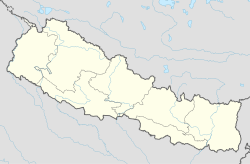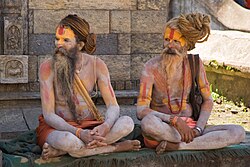Pashupatinath Temple
Hindu temple in Kathmandu From Wikipedia, the free encyclopedia
The Pashupatinath Temple (Nepali: पशुपतिनाथ मन्दिर) is a Hindu temple dedicated to Pashupati, a form of Shiva. It is located in Kathmandu, Nepal, on the bank of the Bagmati River. The temple was classified as a World Heritage Site in 1979. This "extensive Hindu temple precinct" is a "sprawling collection of temples, ashrams, images and inscriptions raised over the centuries along the banks of the sacred Bagmati river", and is one of seven monument groups in UNESCO's designation of Kathmandu Valley.[1] The temple, considered one of the holiest pilgrimage sites for Hindus, is built on an area of 246 hectares (2,460,000 m2)[2] and includes 518 mini-temples and a main pagoda house.
| Pashupatinath Temple | |
|---|---|
श्री पशुपतिनाथ मन्दिर | |
 Pashupatinath Temple, associated with Shiva as 'the lord of all beings' | |
| Religion | |
| Affiliation | Hinduism |
| District | Kathmandu |
| Province | Bagmati Province |
| Deity | Shiva (as Pashupati) |
| Festivals | Maha Shivaratri, Teej |
| Features |
|
| Location | |
| Location | Kathmandu |
| Country | Nepal |
Location in Nepal | |
| Geographic coordinates | 27°42′35″N 85°20′55″E |
| Architecture | |
| Type | Pagoda |
| Date established | 5th century CE |
| Specifications | |
| Site area | 2,460,000 m² |
| Temple(s) | 519 Pagodas |
| Elevation | 817 m (2,680 ft) |
 | |
| Criteria | Cultural: (iii)(iv)(vi) |
| Designated | 1979 (3rd session) |
| Part of | Kathmandu Valley |
| Reference no. | 121bis-006 |
Pashupatinath temple is given a status of one of the most sacred Shiva Kshetras (abodes of Shiva) in Skanda Purana, and is also one of the Paadal Petra Sthalams (Tamil Tevara Sthalam) of Tevaram.[3][4] The linga of Pashupatinath, as described in Shiva Purana, is the bestower of all wishes.[5][6] The temple is worshipped as the head of Shiva with his body in Kashi Vishwanath in India,[7][8][9][10] and is also spiritually connected to the temples of Kedarnath, Rudranath, Kalpeshwar, Madhyamaheshwar and Tungnath as per the legend of Mahabharata.[11][12][13] The main temple priests are, as a tradition, Vedic Dravida Brahmin scholars from Karnataka educated by Śrī Śaṅkarāćārya Dakṣiṇāmnāya Pīṭha, Sringeri.
History
Summarize
Perspective

Pashupatinath Temple is the oldest Hindu temple in Kathmandu. The temple is considered to be pre-Vedic in its origin[14] and according to Nepal Mahatmaya and Himvatkhanda of Skanda Purana, the deity here gained great fame as Pashupati.[15]
As per Shiva Purana, the linga of Pashupatinath that lies in Nepal has the capacity to fulfill all desires, and the story of Pashupatinath is narrated along with the greatness of Kedareshwara (Kedarnath) in the 9th chapter of "Koti-Rudra Samhita" which describes the journey of Pandavas in the search of Shiva. After Pandavas perform much penance, Shiva who had hidden himself underground in the form of a bull, reappears with his head in Pashupatinath, hump in Kedarnath, face in Rudranath, arms in Tungnath and navel in Madhyamaheshwar.[16]
One legend says that Shiva and Parvati took the form of antelopes in the forest on the Bagmati river's east bank. The gods later caught up with him and grabbed him by one of his horns, forcing him to resume his divine form. The broken horn was worshipped as a linga, but over time it was buried and lost. Centuries later a herdsman found one of his cows showering the earth with milk, and after digging at the site, he discovered the divine linga of Pashupatinath.
Pashupatinath Temple's existence is recorded as early as 400 CE.[17] The ornamented pagoda houses the linga of Shiva. According to Gopalraj Aalok Vhat, the temple was built by Prachanda Deva, a Licchavi king. Another chronicle states that Pashupatinath Temple was in the form of Linga shaped Devalaya before Supuspa Deva constructed a five-storey temple of Pashupatinath in this place. As time passed, the temple needed to be repaired and renovated. It is known that this temple was reconstructed by a medieval king named Shivadeva (1099–1126 CE). It was renovated by Ananta Malla adding a roof to it.[18][19] Further temples have been erected around the two-storied temple, including the Vaishnava temple complex with a Rama temple from the 14th century and the Guhyeshwari Temple mentioned in an 11th-century manuscript, overtime. The current form of the temple was renovated in 1692 CE after the previous structures were affected by termites and earthquakes.[20][21]
The main temple complex of Pashupatinath and the sanctum sanctorum was left untouched, but some of the outer buildings in the complex were damaged by the April 2015 Nepal earthquake.
Architecture

This main temple is built in Newari architecture. The two-level roofs are of copper with gold covering. The temple rests on a square base platform with a height of 23m 7 cm from base to pinnacle. It has four main doors, all covered with silver sheets. This temple has a gold pinnacle (peak). Inside are two garbhagrihas: the inner garbhagriha or sanctum sanctorum is where the idol is placed, and the outer sanctum is an open corridor-like space.[22]

Deity
The sacro sanctum, or the main idol, is a stone Mukhalinga with a silver yoni base bound with a silver serpent. It is one metre high and has faces in four directions, which represent various aspects of Shiva; Sadyojata (also known as Barun), Vamadeva (also known as Ardhanareshwara), Tatpurusha, Aghora, and Ishana (imaginative).[23] Each face has tiny protruding hands holding rudraksha mala in the right hand and a kamandalu in the other. Unlike other Shiva lingams in India and Nepal, this lingam is always dressed in its golden vastram except during abhisheka, so pouring milk and Ganga Jal is only possible during the ritual through the main priests.
Priests
Summarize
Perspective

Only four priests can touch the idol. Daily rituals of Pashupatinath are carried out by two groups of priests: the Bhatta and the Rajbhandari. Bhatta perform the daily ritual and can touch the lingam, whereas Rajbhandaris are helpers and temple caretakers who are not qualified to perform puja rituals or to touch the deity.[24]
Bhatta
Bhatta are highly educated Vedic Karnataka Brahmin scholars from Karnataka. Unlike other Hindu temples, the priesthood of Pashupatinath is not hereditary. Priests are selected from a group of scholars. The chosen priest is sent to Kathmandu to perform puja and daily worship of Pashupatinath.
The current Bhatta priests of the temple are:
- Ganesha Bhatta (15th head priest of the Pashupatinath Temple aka Mool Bhat) from Udupi.[25]
- Girisha Bhatta from Sirsi.[25]
- Narayana Bhatta from Bhatkal.[25]
- B.S Binaya Adiga-Bhatta [26]
The current Bhatta priest of the Vasukinath Naag temple of Pashupatinath
- Raghavendra Bhatta

Rajbhandaris
The Rajbhandaris are the treasurers, temple caretakers, and assistant priests of the temple. They are the descendants of helper priests brought up by early Bhatts, but were allowed to settle in Kathmandu valley and later assimilated into the existing Newar caste system of Rajbhandari – a high-caste Chathariya/Kshatriya clan of Kashyapa gotra. Their main task is to help the Bhatt priests and perform maintenance of the inner garbhagriha. They can have little or no Vedic knowledge but still qualify as assistant priests if they belong from the same family lineage and undergo some basic criteria like caste, gotra, lineage purity, and educational qualification. They work in a set of three and switch every full moon day. There are a total of 108 Rajbhandaris.[27][28]
Entry
Summarize
Perspective

The temple courtyard has four entrances in the cardinal directions. The western entrance is the main entrance to the temple courtyard and the remaining three entrances are open only during festivals. The temple security (Armed Police Force Nepal) and the Pashupatinath area development trust are selective regarding who is allowed entry into the inner courtyard. Only practising Hindus of South Asian diaspora and Buddhists of Nepali and Tibetan diaspora are allowed into the temple courtyard. Practising Hindus of Western descent are not allowed into the temple complex and must go no further than other non-Hindu visitors. An exception is granted to Sikhs and Jains of Indian ancestry who may enter the temple complex. Others can look at the main temple from the adjacent side of the river[29] and pay $10 (1,000 Nepali rupees) to visit the small temples located in the external premises of the temple complex.
The inner temple courtyard remains open from 04:00 to 19:00 for the devotees, but the inner Pashupatinath Temple is open from 05:00 to 12:00, for the morning ritual and viewing and from 17:00 to 19:00 for the evening ritual. Unlike many other Shiva temples, devotees are not allowed to enter the inner garbhagriha, but are allowed to watch from the exterior premises of the outer garbhagriha. The temple closing times change depending upon the season: in November, it closes at 18:30. In summers, it closes at 20:00.
Abhisheka
The inner sanctum where the lingam is placed has four entrances: east, west, north, south. From 09:30 to 13:30, devotees can worship from all four doors. All four doors are also opened during abhisheka from 09:00 to 11:00. Abhisheka is done based on the direction the mukh is viewed.
Festivals
There are many festivals throughout the year, such as the Maha Shivaratri and the Teej festival. Teej is one of the most celebrated festival at Pashupatinath Temple.[30]
Buddhist pilgrimage
Summarize
Perspective

Buddhists consider the temple complex as sacred, and is associated with numerous mahasiddhas such as Matsyendranath, Gorakhnath, Padmasambhava, Naropa and Tilopa. The temple area is believed to be the place where Gorakhnath opened up the practices of haṭha yoga to people from all walks of life.[31] In Vajrayana Buddhism, the cremation zone of the temple complex falls under 'Lhundrup Tsek' or 'Spontaneous Mound charnel ground' and is revered among the eight great charnel grounds where Padmasambhava meditated and gained spiritual accomplishments.[32] The two caves situated to the north of the cremation zone along the river banks are worshipped as the meditation caves of mahasiddhas Tilopa and his disciple Naropa. The caves are considered sacred as the site where Naropa received direct teachings from his master Tilopa and had the vision of Vajrayogini.[33] Naropa was also the main teacher of Marpa, the founder of Kagyu school of Tibetan Buddhism who brought Vajrayana teachings to Tibet. Marpa, in turn, was the master of Milarepa, one of Tibet's most famous yogi.[34]
Controversy
Summarize
Perspective

In January 2009, after the forced resignation by the chief priest of Pashupatinath temple, the Maoist-led government of Nepal "hand picked" Nepalese priests of Khas-Gorkhali ethnicity to lead the temple, bypassing the temple's long-standing requirements.[35] This appointment was contested by the Rajbhandaris (temple caretakers) of the temple, stating that they were not against the appointment of Nepalese priests but against the appointment without proper procedure.[36] After the appointment was challenged in a civil court, the appointment was overruled by the Supreme Court of Nepal,[37][38] but the government ignored the ruling and stood by its decision, which led to public outrage and protests over a lack of transparency. A clash between the youth wing of the Communist Party of Nepal (Maoist) and the protesting temple staff caused over a dozen injuries when some 100 Maoist cadres attacked the temple caretakers,[39] though the maoists denied the attack.[40][41] Lawmakers and activists from opposition parties joined protests, declaring their support for the Bhatt and other pro-Bhatt protesters.[42] After long dissatisfaction and protest by Hindus both in and outside Nepal, the government was forced to reverse its decision and reinstate Bhatta priests.
Gallery
- Pashupatinath at night
- 15 shivalayas
- Wandering ascetics of Pashupatinath
- Bagmati river
- Buddha statue
- Goddess temple in Pashupatinath
- Goddess temple
References
Further reading
External links
Wikiwand - on
Seamless Wikipedia browsing. On steroids.










